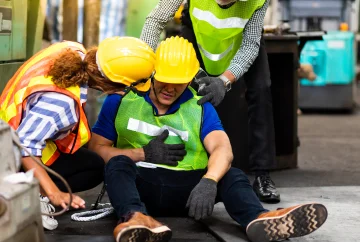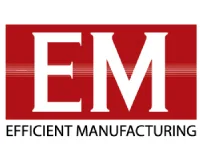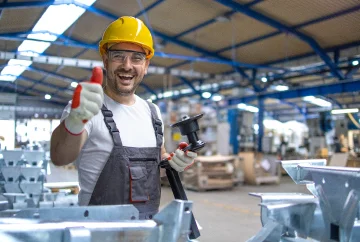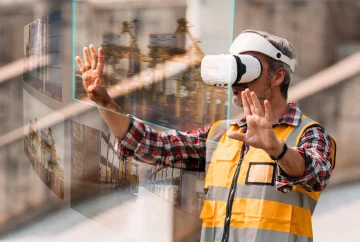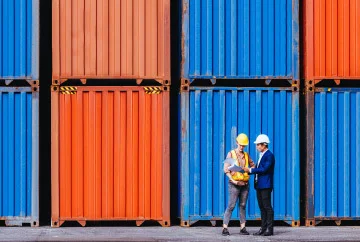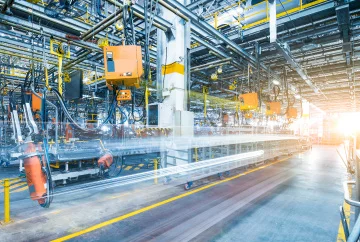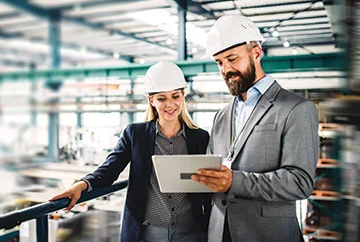- Connected Facilities with Cloud Platforms:
Some of the most advanced manufacturing facilities in the world are now leveraging cloud platforms to orchestrate their operations. A key benefit of adopting cloud platforms is facilitating seamless connectivity between employees in the field, on the production line and the control room, building continuity between people and software-driven processes.
A number of hazards are often caused by operating machinery without knowing if there are workers at risk – such hazards can be prevented by patching location data from employee wearables in the OT environment, thereby eliminating the need for repeated safety audits and phone calls. Moreover, cloud platforms also enable the integration of visual feeds, IoT data and maintenance status of equipment from ERP to contextualize risk and to automatically issue alerts to employees at risk.
Lastly, the health and safety benefits of facilities connected via IoT and cloud are multifold. As enterprises deploy new solutions, more machines and sensors, they can further advance their EHS roadmaps by bringing new data points and evolving their safety protocols enforcement and alerting systems.
- Automation for Materials Handling:
Manual materials handling can lead to repetitive motion strategies, risks resulting from human errors, trips and falls and exertion. Moreover, handling hazardous materials, such as chemicals, can cause significant risks to other workers. Therefore, automated materials handling is another term for making robots carry out the handling process. Automated materials handling is an umbrella term for a few technologies, such as automated storage and retrieval systems, automated vehicles, cobots and rail-guided vehicles, that help implement a goods-to-people process map in a production facility or a warehouse. Such technologies enable storage and retrieval from high-rise shelves, eliminate human risk from carrying hazardous materials and eliminate non-ergonomic postures from the employees’ workday.
Automating materials handling also injects efficiency, speed & precision into manufacturing processes, thereby reducing risks from human errors and improper judgment from fatigue. Lastly, automation technologies can also enhance worker safety in other processes, such as welding, forging, cutting, etc.
- AR/VR for Safety Training and Simulations:
A key cause of safety hazards in manufacturing environments is inadequate training. Workers often decide to handle machinery without receiving training, and safety protocols are ignored in real-time scenarios. Moreover, some hazardous incidents also occur during training sessions. Another disadvantage of classroom safety training is the inability to form sticky habits through repetition and disengaging instruction.
This is where AR/VR technologies come into play. With VR, employees can receive immersive safety training in a risk-free environment, with the added possibility of repeating simulations.
This helps develop habits that stick, and such simulations can be monitored for helping employees achieve satisfactory training levels before deploying them in real-life scenarios.
Lastly, AR is an effective technology not only for guiding repairmen through quick and successful repairs but also for delivering safety instructions and updating them on risk factors in real-time.
- Computer Vision for Safety Guidelines Compliance:
In the manufacturing industry, personal protective equipment (PPE) plays a key role in helping workers navigate risky environments. For instance, various safety boots with stringent technical specifications can help prevent slippage, falls from ladders, toe injuries from heavy materials or trips or exposure to chemicals. Similarly, other processes call for acid-proof gloves, safety goggles or industrial noise-cancelling equipment.
However, providing such equipment and outlining the policies regarding PPE usage alone is not adequate to prevent hazards resulting from non-compliance with PPE guidelines. For such situations, computer vision solutions can help ensure that each worker that enters a risky environment is adhering to PPE usage guidelines. By processing images of workers or monitoring video feeds in real-time, such systems can alert if a worker is not using PPE in an area. Such systems can also be patched with insurance and compensation policies or the ensuing implications of not complying with PPE guidelines while reinstating the risk factors as and when incidents are detected.
- Predictive Maintenance to Prevent Hazards:
Another key cause of safety hazards is running machinery to the point of malfunction or not knowing how repair processes are interdependent on other processes in the environment. For instance, a malfunctioning cooling system can lead to condensation build-up and cause an electrical hazard – similarly, and a worker might touch a hot bearing, conduct a repair during a gas build-up and so on.
Therefore, predictive maintenance is not only a key use case for extending asset life and health but also a critical aspect of ensuring a safe environment for all the workers in the facility. Machine malfunctions usually directly affect the operators and sometimes also pose a risk to others in the environment. Predictive maintenance systems not only help prevent mishaps arising from malfunctions but also enable workers to conduct repairs in safe windows. Lastly, predictive maintenance also reduces the need for inspections in risky environments, thereby subtracting from the costs of audits and risks of inspecting machinery that is in operation.
- AI for Risk Detection, Reaction, and Warning:
While AI drives several employee safety use cases, such as computer vision for PPE detection and predictive maintenance, there are a number of other applications too. For instance, AI and ML can be applied to real-time video feeds, sensor data, location data or health data from wearables.
Anomaly detection algorithms applied to sensor data can detect leakages, untimely malfunctions, gas build-up, exceeding temperature or pressure ranges and so on. Similarly, video feeds of outdoor facilities can be monitored for fire or accidents, and adequate actions can be taken immediately. Moreover, AI algorithms can also pick irregularities from health data from wearables or contextualize risk detection with location data to issue timely alerts to workers of a potential hazard.
- Automating Construction Safety Documents:
Electronic documentation is a key step in elevating worker safety levels, enforcing accountability across the organization, building visibility into whether safety conditions and compliance requirements are being met and if there are identifiable trends leading to repeated risk exposure for workers on the field. While document automation is also being built into EHS software these days, there are other solutions that specialize in provisioning fillable forms in a device-agnostic manner and speeding safety policies adherence.
In construction, manufacturing, O&G and mining, automation of safety documents can help save tens of hours per week while building a central repository of verifiable, past safety checks – all of them accessible from a central location. Patched with safety incident reporting systems, such records can enable facility managers to spot hazard trends and take mitigative actions to prevent the repetition of such incidents. Lastly, electronic documentation also simplifies access, multi-party collaboration and job site quality management without the need for investing in additional hardware on-field or maintaining paperwork.
- Smart Wearables for Worker Safety:
Smart wearables are a class of equipment that can perform a number of functions to promote worker safety and health in hazardous environments. Such wearables make use of a number of technologies such as smart sensors, AR/VR, and embedded AI/ML to deliver alerts and preventive actions to workers.
So far, manufacturing environments have seen workers wearing smart vests that can detect extreme temperature stress, excessive forceful vibrations, physical fatigue and whether sufficient rest breaks are being taken in high exertion processes.
Smart wearables can also be patched with EHS and OT systems to cross-contextualize data within both systems.
For instance, a worker doing repetitive tasks and load lifting simultaneously could develop an injury spontaneously – in such a situation, medical safety teams can be dispatched to the worker’s location immediately, and appropriate next steps are taken without delay.
Smart wearables can also help gauge a worker’s physical and psychological health indicators, stress and fatigue levels, or even detect impacts and injuries as they occur in real-time.
- Helmet-Mounted Sensor Tags:
With the reducing cost of sensors, personal protective equipment has been turned into smart safety items that do much more than protecting the head or feet. Safety helmets, for example, are being purpose-built for the job that a field worker does daily. Employees that conduct electrical repair can often unknowingly damage electrical equipment or subject themselves to shocks due to undetected electrostatic fields. Today, helmets of linemen can be augmented with sensor tags that run on AA batteries and assist them in detecting electrical fields from a few meters away.
Similarly, workers that operate in risky environments or handle heavy machinery can be alerted on their proximity with other workers. To do so, their helmets can be augmented with singleantenna IoT devices. As soon as another worker wearing a similar helmet is detected in proximity, the helmet delivers audible alerts in the form of a beep. Such devices can be configured to alert the workers on a customised range of proximity, and this information can also be injected into operational technology software to alert operators of workers in proximity with a machine on the field.
- Building a People-First Culture:
Lastly, cultural aspects are a significant aspect of employee safety. A number of misconceptions and mindsets can lead to the propagation of risky behavior in the workspace. For instance, considering that safety subtracts from productivity or that risk is a part of the job can continuously hinder realizing a people-first culture. While digital technologies can help mitigate some of the risks, a people-first culture goes a long way in navigating through the blind spots, helping avoid long-term damage to the organization and its people, and digitally transforming for proactive safety in the first place. Some of the ways to build a people-first culture include rewarding safety behaviors, communicating a people-first vision across managers responsible for facilities, acknowledging hazardous incidents and collectively learning from them.
In the process of building a people-first culture at a manufacturing organization, senior leaders must reform their vision of employee safety. Many organizations look at employee safety as just another checkbox to tick for compliance adherence. On the other hand, a people-first culture views regulations as drivers of people's safety in risky environments; therefore, safety regulations form the baseline. Today, smart technologies have taken people's safety in risky workplaces to the next level – risks can be detected in advance, and hazards can be mitigated before they occur. As a result, technology is at the forefront of a people-first culture in the manufacturing industry.
